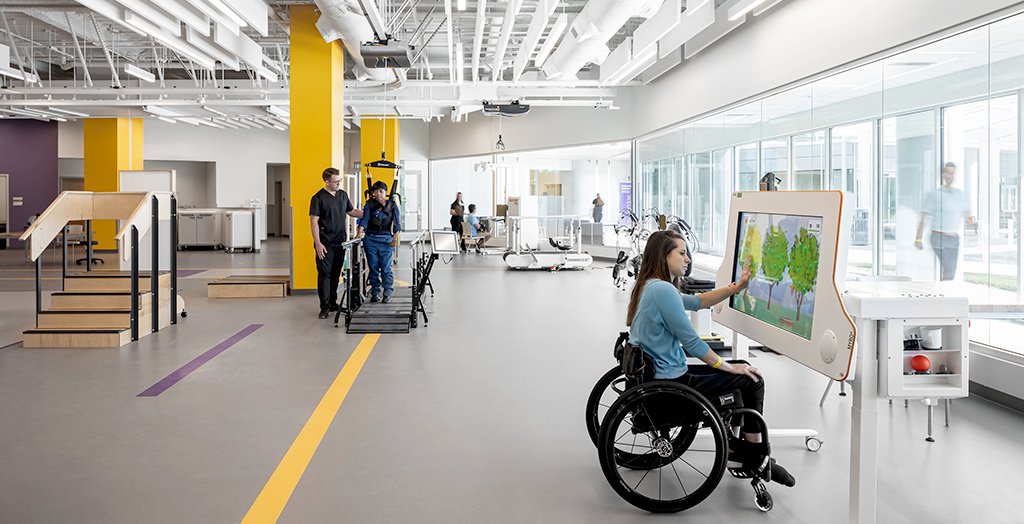Rehabilitation centers play a crucial role in helping individuals recover from various physical, mental, and emotional health issues. Whether someone is recovering from addiction, a traumatic injury, or a debilitating mental health disorder, rehabilitation centers provide a structured environment where they can receive professional care, therapeutic interventions, and support to regain their independence and improve their quality of life. This article explores the concept of rehabilitation centers, how they function, the various types, and answers common questions about them.
Key Takeaway
It’s important to select the right rehabilitation center based on your specific health needs, and insurance coverage should be considered when choosing a facility.
Rehabilitation centers provide specialized care for a range of physical, mental, and emotional health issues.
These centers offer a structured environment, personalized treatment plans, and access to professional support to help individuals recover and regain their independence.
Rehabilitation programs can vary in duration and intensity, depending on the individual’s needs and condition.
What is a Rehabilitation Center?
A rehabilitation center is a specialized medical facility designed to help people recover from health conditions that impair their ability to perform everyday activities. These centers focus on rehabilitation, which means restoring a person’s physical, mental, or emotional health to its highest possible level. Rehabilitation centers are often used for a wide range of conditions, such as:
- Physical rehabilitation after an injury or surgery
- Drug or alcohol addiction rehabilitation
- Mental health rehabilitation for conditions like depression, anxiety, and PTSD
- Neurological rehabilitation for conditions like stroke, brain injury, or spinal cord injury
- Occupational therapy to help individuals regain the skills needed for everyday life and work
Rehabilitation centers can offer inpatient or outpatient services, depending on the severity of the individual’s condition and the type of care they require. These facilities provide a comprehensive treatment plan that may include therapy, medication management, and other interventions that are customized to each person’s needs.
Types of Rehabilitation Centers
There are different types of rehabilitation centers, each focused on specific aspects of recovery. Let’s take a closer look at some common types:
1. Physical Rehabilitation Centers
These centers primarily help individuals who are recovering from injuries or surgeries that affect their physical mobility. They focus on improving physical function, strength, and endurance through physical therapy, occupational therapy, and other interventions. Some common conditions treated at physical rehabilitation centers include:
- Post-surgical recovery
- Orthopedic injuries
- Stroke recovery
- Traumatic brain injuries
- Spinal cord injuries
2. Addiction Rehabilitation Centers
Addiction rehabilitation centers are designed to help individuals struggling with substance abuse and addiction. These centers provide both inpatient and outpatient services, depending on the individual’s needs. The goal is to help individuals overcome their dependency on substances like alcohol, drugs, or prescription medications. Addiction rehabilitation programs typically include:
- Detoxification (detox) services
- Counseling and therapy
- Support groups (e.g., 12-step programs like Alcoholics Anonymous)
- Aftercare and relapse prevention
3. Mental Health Rehabilitation Centers

Mental health rehabilitation centers focus on providing treatment and therapy for individuals struggling with psychiatric disorders, including depression, anxiety, bipolar disorder, PTSD, and schizophrenia. These centers offer specialized care, including psychotherapy, medication management, and support for those living with mental health challenges. They may provide a combination of individual therapy, group therapy, and medication to help individuals cope with their symptoms.
4. Neurological Rehabilitation Centers
Neurological rehabilitation centers cater to individuals who have experienced neurological injuries or conditions, such as stroke, brain injury, multiple sclerosis, and Parkinson’s disease. These centers offer a combination of physical therapy, speech therapy, and cognitive rehabilitation to help individuals regain lost functions, improve motor skills, and develop strategies for coping with their conditions.
5. Pediatric Rehabilitation Centers
Pediatric rehabilitation centers provide specialized care for children with physical, cognitive, and emotional health conditions. They address a wide range of needs, from developmental disorders to physical disabilities, and help children achieve their developmental milestones, enhance motor skills, and manage any chronic conditions they may face.
6. Geriatric Rehabilitation Centers
These centers focus on the rehabilitation needs of older adults, particularly those dealing with age-related health issues such as arthritis, osteoporosis, dementia, and stroke. Geriatric rehabilitation centers aim to help elderly individuals regain or maintain their independence, mobility, and overall quality of life.
7. Cardiac Rehabilitation Centers
Cardiac rehabilitation centers specialize in helping individuals recover after heart-related conditions such as heart attacks, bypass surgery, or other cardiovascular surgeries. These centers offer programs designed to improve heart health through exercise, nutritional counseling, stress management, and medication management.
How Does a Rehabilitation Center Work?
A rehabilitation center works by offering a structured and comprehensive treatment program that is personalized for each individual. Depending on the type of rehabilitation required, the treatment plan may include:
- Assessment: Before starting any rehabilitation program, an individual will undergo an assessment to determine their physical, mental, and emotional needs. This may involve a physical examination, psychological evaluation, and other diagnostic tests to determine the best course of treatment.
- Personalized Treatment Plan: Based on the assessment results, a personalized treatment plan is developed. This plan may include therapy, medications, and lifestyle changes tailored to the individual’s needs.
- Therapies and Services: Most rehabilitation centers offer a variety of therapies, such as physical therapy, occupational therapy, speech therapy, cognitive therapy, and psychological counseling. These therapies are designed to help individuals regain function, improve mental health, and manage their condition.
- Ongoing Monitoring: Throughout the rehabilitation process, the individual’s progress is monitored by healthcare professionals. Adjustments may be made to the treatment plan as necessary to ensure the best outcomes.
- Discharge and Aftercare: Once the rehabilitation process is complete, the individual may be discharged from the center. However, many centers offer aftercare services to help individuals continue their recovery at home. This may include follow-up therapy sessions, support groups, or home care services.
Benefits of Rehabilitation Centers

Rehabilitation centers provide several benefits for individuals who are recovering from health issues. Some of the key benefits include:
1. Comprehensive Care
Rehabilitation centers offer a holistic approach to care, addressing not only physical needs but also mental, emotional, and psychological health. This comprehensive care ensures that individuals receive the support they need in all areas of their recovery.
2. Specialized Services
Rehabilitation centers often employ a multidisciplinary team of healthcare professionals, including physicians, therapists, psychologists, and social workers. This allows for specialized care tailored to the specific needs of each individual.
3. Structured Environment
A rehabilitation center provides a structured and supportive environment where individuals can focus on their recovery without distractions. This controlled setting helps individuals follow a treatment plan and stay on track with their progress.
4. Peer Support
In addiction and mental health rehabilitation centers, individuals benefit from the support of others who are going through similar struggles. Group therapy and support groups foster a sense of community and belonging, which can be an essential part of recovery.
5. Access to Resources
Rehabilitation centers have access to a wide range of resources, including medical equipment, therapy tools, and specialized treatments that may not be available in other settings. This ensures that individuals have everything they need to achieve the best possible outcomes.
The Role of Occupational Therapy in Rehabilitation Centers
Overview:
Occupational therapy (OT) plays a key role in helping individuals regain the skills needed for everyday life. This could include tasks such as dressing, cooking, bathing, or returning to work. Occupational therapy is often a significant part of rehabilitation programs for people recovering from surgery, brain injuries, strokes, or chronic conditions.
Key Points to Cover:
- Definition and goals of occupational therapy
- The importance of OT in regaining independence
- Types of conditions that benefit from OT
- How OT is integrated into rehabilitation programs
- Success stories and the impact of OT in rehabilitation settings
- Tools and equipment used in occupational therapy
- Training and qualifications for occupational therapists
Understanding Physical Therapy and Its Benefits in Rehabilitation
Overview:
Physical therapy is crucial for restoring physical function, strength, and mobility in individuals recovering from injuries or surgeries. A well-structured physical therapy program can help individuals regain function, prevent further injury, and improve overall quality of life.
Key Points to Cover:
- What is physical therapy and why it’s important in rehabilitation
- The different types of physical therapy (manual therapy, exercise therapy, hydrotherapy, etc.)
- How physical therapy helps with pain management
- Rehabilitation for specific conditions: arthritis, spinal injuries, fractures, post-surgery recovery
- Phases of a physical therapy program
- The role of physical therapists in rehabilitation centers
- The importance of customized physical therapy plans for individual needs
The Impact of Mental Health Rehabilitation on Recovery

Overview:
Mental health rehabilitation centers focus on helping individuals suffering from various psychological disorders such as anxiety, depression, PTSD, and schizophrenia. These centers provide therapies such as cognitive-behavioral therapy (CBT), psychotherapy, and medication management to help patients manage their symptoms and improve their overall well-being.
Key Points to Cover:
- What is mental health rehabilitation and why is it needed?
- Common mental health conditions treated in rehabilitation centers
- Treatment modalities (individual therapy, group therapy, family therapy, medication management)
- The role of mental health professionals (psychologists, psychiatrists, counselors)
- Coping strategies taught in rehabilitation centers
- How rehabilitation centers create a supportive environment for mental health recovery
- Importance of aftercare and continued support
Addiction Recovery Programs: What to Expect at a Rehab Center
Overview:
Addiction rehabilitation centers help individuals overcome substance abuse and dependency. This includes alcohol, drugs, prescription medication, and behavioral addictions like gambling. Rehab centers offer detoxification, counseling, and long-term recovery programs to help individuals regain control over their lives.
Key Points to Cover:
- The stages of addiction and the recovery process
- Detoxification: What it involves and why it’s necessary
- Types of addiction treatment programs (inpatient vs. outpatient, 12-step programs, dual diagnosis treatment)
- Counseling and therapy options (CBT, dialectical behavior therapy (DBT), family therapy)
- Relapse prevention strategies
- Aftercare programs and sober living environments
- How to choose the right addiction rehab center
- The importance of support systems during recovery (family, friends, peer support groups)
Cardiac Rehabilitation: The Importance of Recovery After a Heart Event
Overview:
Cardiac rehabilitation centers specialize in helping individuals recover after heart attacks, heart surgeries, or other cardiovascular conditions. These centers provide patients with exercise programs, dietary advice, and psychological support to improve heart health and prevent further cardiac issues.
Key Points to Cover:
- What cardiac rehabilitation entails
- The role of exercise, diet, and lifestyle changes in cardiac recovery
- How rehabilitation helps reduce the risk of heart disease recurrence
- The importance of stress management and psychological support
- Phases of cardiac rehabilitation (acute, subacute, maintenance)
- The role of healthcare professionals in cardiac rehab (cardiologists, exercise physiologists, dietitians)
- Monitoring progress and setting long-term heart health goals
Neurological Rehabilitation: Helping Individuals Recover from Brain and Nervous System Injuries
Overview:
Neurological rehabilitation centers focus on helping individuals who have suffered from brain injuries, strokes, Parkinson’s disease, multiple sclerosis, or other neurological disorders. These centers provide a range of therapies to improve mobility, cognition, speech, and overall functionality.
Key Points to Cover:
- What neurological rehabilitation involves and why it’s important
- Treatment strategies for different neurological conditions (stroke, traumatic brain injury, MS, etc.)
- Speech therapy, cognitive therapy, and physical rehabilitation in neurological care
- The role of neuropsychologists in treating cognitive issues
- Importance of patient-centered care and personalized rehabilitation plans
- The need for multidisciplinary teams in neurological rehab
- Success stories and how rehabilitation has helped individuals live with neurological conditions
Geriatric Rehabilitation: Addressing the Needs of Older Adults
Overview:
Geriatric rehabilitation centers cater to the elderly population, addressing the unique challenges they face, such as chronic diseases, mobility issues, cognitive decline, and recovery after surgery. Geriatric rehabilitation focuses on helping older adults maintain or improve their independence and quality of life.
Key Points to Cover:
- What geriatric rehabilitation is and why it’s important
- Common conditions treated in geriatric rehabilitation (dementia, osteoporosis, arthritis, stroke)
- The role of physical therapy, occupational therapy, and speech therapy in geriatric care
- Tailored rehabilitation programs for older adults
- How rehabilitation helps prevent falls and injuries in the elderly
- The impact of rehabilitation on mental health in aging individuals
- Family involvement in the rehabilitation process of elderly individuals
Pediatric Rehabilitation: Helping Children Recover from Injuries and Disorders
Overview:
Pediatric rehabilitation centers specialize in helping children with physical, cognitive, and developmental disabilities. Whether due to birth defects, injuries, or illnesses, these centers focus on assisting children in regaining the skills and functions needed to live their lives as fully as possible.
Key Points to Cover:
- What pediatric rehabilitation entails and its importance
- Conditions commonly treated in pediatric rehabilitation (cerebral palsy, autism, developmental delays)
- The role of speech, occupational, and physical therapies for children
- How pediatric rehab centers create a child-friendly environment for recovery
- Family-centered care in pediatric rehabilitation
- Techniques used to engage children in therapy (play therapy, art therapy)
- The role of early intervention in successful outcomes
The Role of Technology in Modern Rehabilitation
Overview:
Technology is increasingly playing a role in rehabilitation, from virtual reality therapy to robotic-assisted therapy devices. Advances in technology are making rehabilitation more effective, efficient, and accessible.
Key Points to Cover:
- How technology is integrated into physical, mental, and neurological rehabilitation
- Virtual reality for pain management, movement training, and cognitive therapy
- Robotic therapy devices for mobility and motor skill recovery
- Telemedicine and remote rehabilitation services
- The benefits and challenges of using technology in rehabilitation
- Case studies and real-life examples of technology improving outcomes
- The future of technology in rehabilitation (AI, wearable devices, etc.)
Center Staffing: Who Are the Professionals Involved?
Overview:
Rehabilitation centers rely on a diverse team of healthcare professionals to provide comprehensive care. These include physical therapists, occupational therapists, speech therapists, psychologists, medical doctors, and social workers. Each professional plays a specific role in helping individuals recover from their conditions.
Key Points to Cover:
- The roles of healthcare professionals in rehabilitation centers
- How a multidisciplinary team works together to create an individualized rehabilitation plan
- Training, qualifications, and specializations required for rehabilitation professionals
- The importance of collaboration in patient care
- The role of support staff, such as nurses and care coordinators
- How rehabilitation centers recruit and retain qualified staff
- The growing demand for rehabilitation professionals and trends in the industry
The Importance of Aftercare and Long-Term Support After Rehabilitation
Overview:
After an individual completes a rehabilitation program, continued support is critical for ensuring lasting recovery. Aftercare programs include follow-up therapy, support groups, and community resources to help individuals stay on track with their recovery.
Key Points to Cover:
- What aftercare is and why it’s important
- The role of ongoing therapy and support in relapse prevention
- Types of aftercare programs available (outpatient therapy, home care services, sober living)
- The impact of family and community involvement on long-term success
- How aftercare helps individuals transition back to normal life
- The challenges of post-rehabilitation and how to address them
Conclusion
Rehabilitation centers are essential resources for individuals Recovering from a wide range of health conditions. Whether someone is recovering from addiction, injury, or mental health challenges, these centers offer specialized care and therapies to help individuals regain their independence and improve their quality of life. Choosing the right rehabilitation center and understanding the treatment options available can play a significant role in achieving a successful recovery.
Also Read : What Is Physical Rehabilitation? Understanding The Process.
FAQs
1. What is the difference between inpatient and outpatient rehabilitation?
Inpatient rehabilitation requires individuals to live at the rehabilitation center during their treatment, while outpatient rehabilitation allows individuals to receive treatment while living at home. Inpatient care is generally recommended for more severe cases, while outpatient care may be appropriate for those with less intensive needs.
2. How long do rehabilitation programs last?
The duration of a rehabilitation program depends on the individual’s condition and progress. Programs can range from a few weeks to several months, with some individuals requiring longer-term care.
3. Will my insurance cover rehabilitation treatment?
Many insurance plans cover rehabilitation treatment, but the extent of coverage varies. It’s important to check with your insurance provider to understand what services are covered under your plan.
4. Are rehabilitation centers only for addiction treatment?
No, rehabilitation centers cater to a wide variety of health conditions, including physical injuries, neurological disorders, mental health issues, and addiction. Each rehabilitation center may specialize in a particular area, so it’s important to find one that fits your needs.
5. Can I choose which rehabilitation center to attend?
Yes, individuals are typically free to choose their rehabilitation center. However, it’s important to consider factors like the center’s reputation, location, and treatment options when making your choice.
6. Do I need a referral to go to a rehabilitation center?
In most cases, you will need a referral from a healthcare provider to attend a rehabilitation center. However, some centers may accept self-referrals or referrals from family members.
7. What happens after I complete my rehabilitation program?
After completing a rehabilitation program, many individuals transition to aftercare, which can include follow-up therapy, support groups, and continued medical care. This helps ensure long-term success and recovery.

